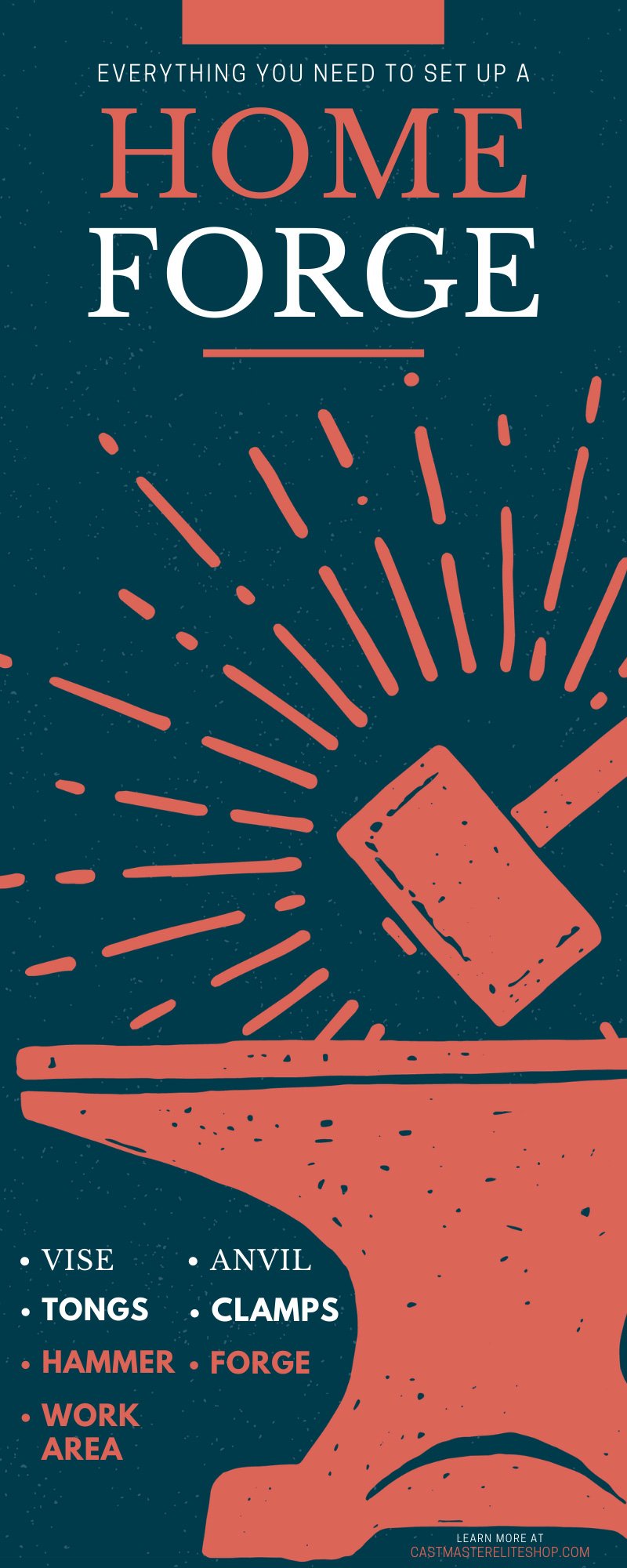Of course, in the beginning stages, you need to decide what type of smithing you’d like to start with. Though there are similarities between each type of metalwork, they are different depending on what you’re producing. Blacksmithing is the most popular type of smithing, and it offers an extensive list of possible forged products. Once you’ve decided, you’ll need to start putting together everything you need to set up a home forge.
WORK AREA
As you start to set up your work area, consider finding a space where you can work uninterrupted. You’ll want level surfaces, open space, and it should be clean. Be sure to remove any flammable items from your new workspace.
Avoid leaving objects and materials around that would clutter the floor area and cause anyone to trip or fall. You don’t want to have hazards of any kind in your new forge. Ensure the space you set up is equipped with shop cleaning materials, as well, such as rags to wipe things down and a broom and dustpan to sweep up debris. Additionally, you’ll need room for the ventilation of your equipment. A forge needs to be able to take in air and let it out.
GATHER TOOLS
You’ll need several tools to begin. Start with the main requirements, and as you perfect your skills, you can forge additional tools for yourself. These types of materials can be acquired from several different sources. Some tools can be found at tools stores, while the items needed to aid in forging can be found with Cast Master Elite.
ANVIL
Steel anvils, also known as forging anvils, are mainly used for blacksmithing. They can range in weight from under ten pounds to a couple hundred. Anvils come in many shapes and sizes. The anvils used in this type of smithing usually contain the greatest mass concentration under the face. They don’t have to be made of steel, however. Some are made of cast iron.
VISE
A vise is meant to hold heated metals in place while they’re being hammered or manipulated. They are meant to be used heavily and withstand extensive work. When blacksmithing, this tool is one of the most crucial to acquire and is referred to as a solid box vise or a blacksmith leg vise. They can last over two hundred years and be passed down through generations of smithing if the vise is of good quality.
HAMMER
Typically, in blacksmithing and many other forms of metalwork, the cross peen (also called the cross pein) hammer is used. It has a wedge on the head’s end that angles horizontally to the handle of the hammer. This is the hammer you should start with, but as time goes on, you can forge your own hammers to use depending on your needs.
CLAMPS
Clamps are used in smithing, and they are similar to a vice, only smaller in scale. They’re used to clamp any item you’re smithing to the anvil and can keep it in place. Clamps can be readjusted easily and come in many different sizes and shapes, depending on the work being done.
TONGS
Tongs allow smiths to grab, move, and rotate metal in the red-hot forge. With the use of a coke forge where coal is used, tongs can place metal deep into the coals, which burn quickly to heat the item you’ve placed in the coals. This tool is another that you can begin making additional sets of as your skill grows. However, to begin, consider Cast Master Elite’s crucible tongs that are rated to withstand extremely high temperatures.
FORGE
The forge is integral to the entire process of forging—it heats the metal you want to mold; you couldn’t do forging at all if you didn’t have one. There are different types of forges that exist. Both coal and propane are viable fuel sources for a forge, but propane offers more control.
Investing in our gas blacksmith forge for sale allows for more convenience and cleanliness while you work. As mentioned earlier, forges need a lot of air and fuel in order to work correctly. When working with propane, you have a fan, rather than the bellows, accompanied by a coke forge.
LEARNING
Learning blacksmithing is a continuous process. You’ll always be perfecting your techniques and finding ways to be more efficient. Once you’ve mastered blacksmithing, you could even teach others or at least mentor them. There is much to know about this trade, and yet, considering how long it’s been around, not much has changed about it. This type of metalwork is established, and the tools and techniques used have been confirmed through centuries of success.
TAKE A CLASS
As you begin, take a class to ensure that you fully understand everything you need to set up a home forge. By taking the guidance of a professional and observing the best shop dynamic and structuring, you should be able to gain a comprehensive understanding of how to set up a shop, so it’s both safe and effective. Understanding the reasoning behind the order of equipment and of operations will become clearer. You’ll also be able to acquire the basic fundamentals to operate safely in your at-home setup.
FIND A MENTOR
A mentor is separate from your teacher. When you take a class, your teacher has to focus on multiple people and their techniques. You want to be able to get some one-on-one support to ensure you’re working carefully and that your developing skill needs no adjusting. (Or, if they do need adjusting, a mentor can help you do that.)
Spending time with an experienced smith can help you establish practices and protocols for forge area maintenance and rules. Additionally, you can observe each other to determine skills that need improvement on your end and efficient ways of completing tasks. If you cannot find a mentor, ask your class teacher if they know of anyone that could help. Be sure that you’re serious about learning all of this before taking up someone else’s time.
PRACTICE
That old saying “practice makes perfect” will always ring true. Learning metalwork will take time, effort, and will also mean you’ll make a lot of mistakes at first. Be gentle with yourself. Everyone had a first experience with smithing and had to work from there. This is going to take commitment and dedication if you want to be good at it.
Whether you’re embarking on the smithing path for a hobby, art, or to start a business, your skills will need to be worked on. Gathering the supplies and understanding their proper uses is key in the beginning. The rest will come with time.







